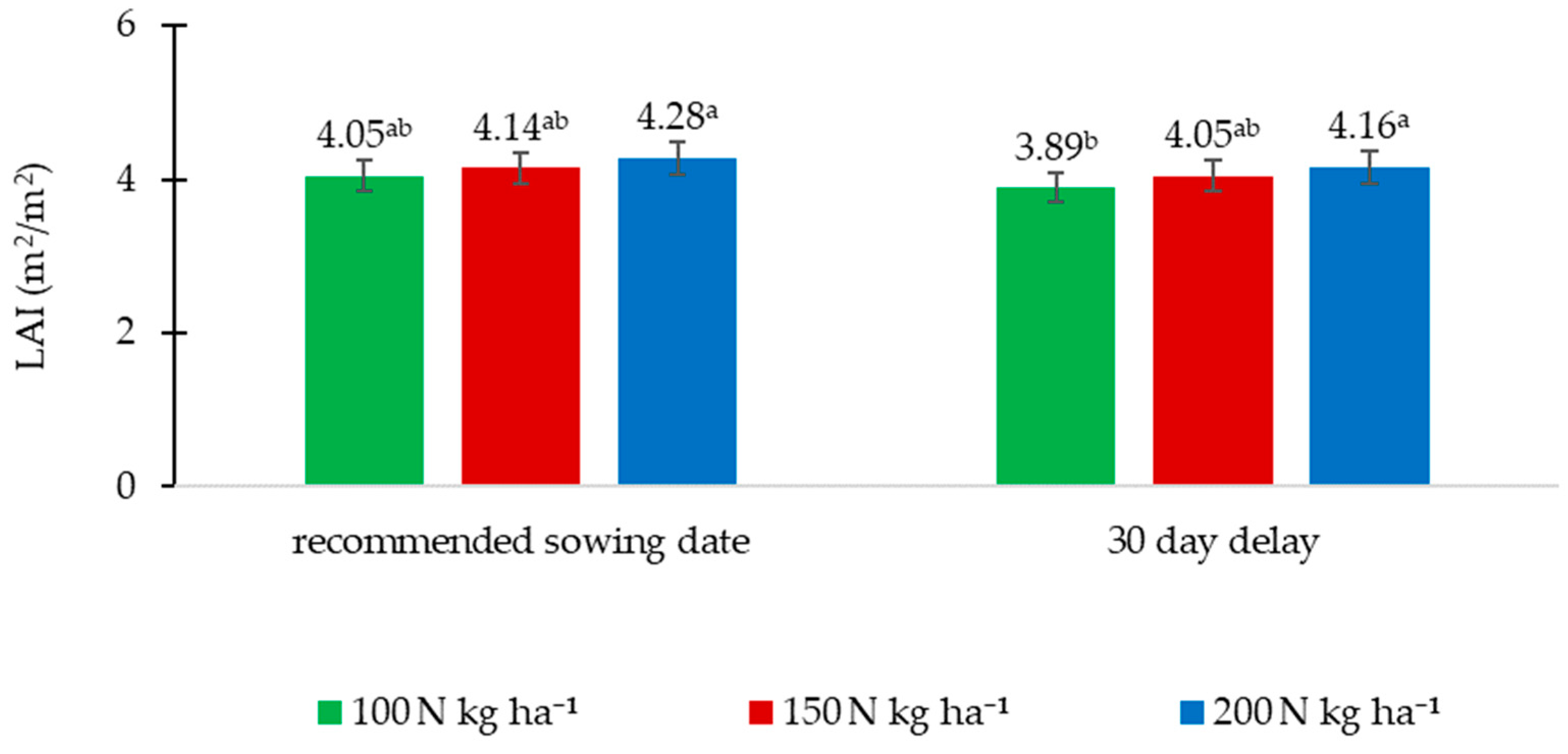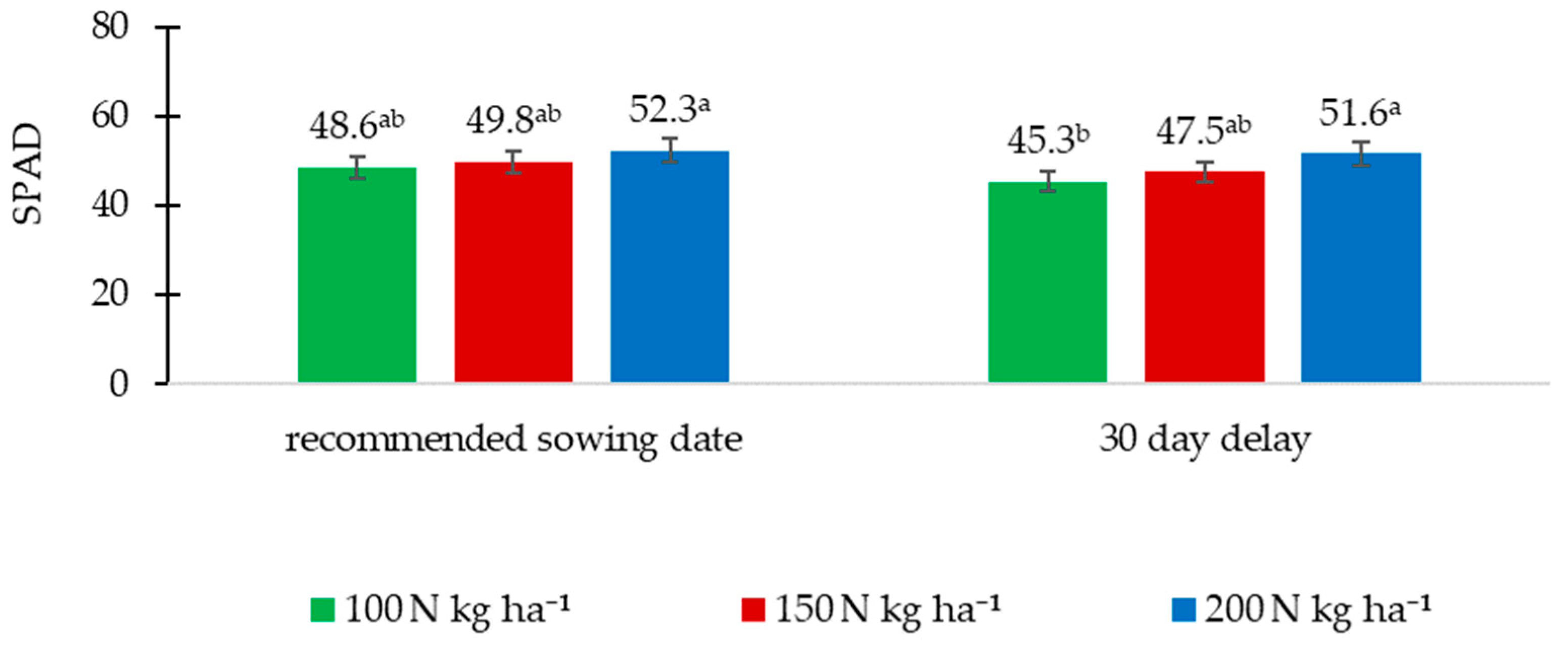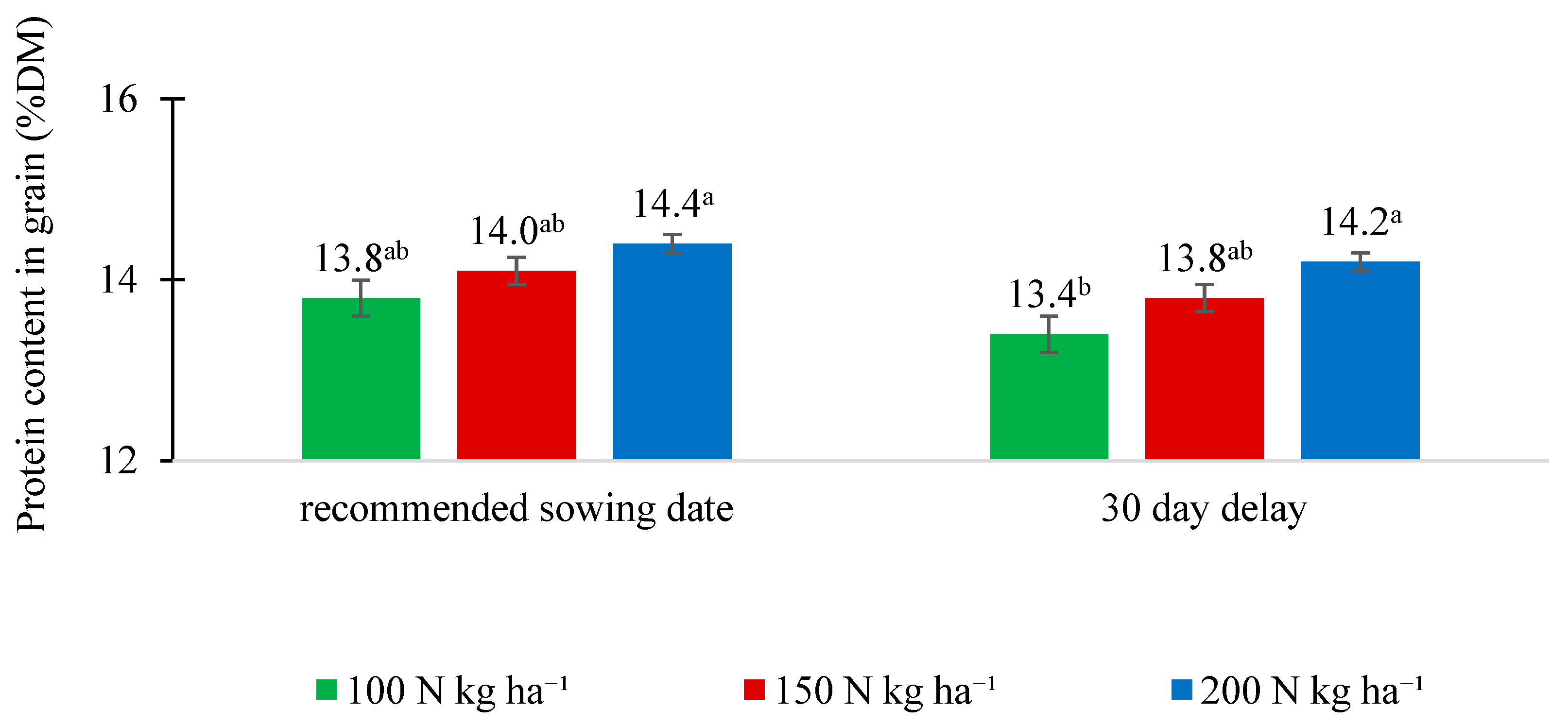Response of Winter Wheat to Delayed Sowing and Varied Nitrogen Fertilization
Abstract
:1. Introduction
2. Materials and Methods
3. Results and Discussion
4. Conclusions
Funding
Institutional Review Board Statement
Data Availability Statement
Acknowledgments
Conflicts of Interest
References
- Shiferaw, B.; Smale, M.; Braun, H.J.; Duveiller, E.; Reynolds, M.; Muricho, G. Crops that feed the world 10. Past successes and future challenges to the role played by wheat in global food security. Food Secur. 2013, 5, 291–317. [Google Scholar] [CrossRef]
- Yang, C.; Fraga, H.; Van Ieperen, W.; Trindade, H.; Santos, J.A. Effects of climate change and adaptation options on winter wheat yield under rainfed Mediterranean conditions in southern Portugal. Clim. Chang. 2019, 154, 159–178. [Google Scholar] [CrossRef]
- Jeyasri, R.; Muthuramalingam, P.; Satish, L.; Pandian, S.K.; Chen, J.-T.; Ahmar, S.; Wang, X.; Mora-Poblete, F.; Ramesh, M. An overview of abiotic stress in cereal crops: Negative impacts, regulation, biotechnology and integrated omics. Plants 2021, 10, 1472. [Google Scholar] [CrossRef] [PubMed]
- Chiriţă, S.; Rusu, T.; Urda, C.; Cheţan, F.; Racz, I. Winter wheat yield and quality depending on chemical fertilization, different treatments and tillage systems. AgroLife Sci. J. 2023, 12, 34–39. [Google Scholar] [CrossRef]
- Neupane, D.; Adhikari, P.; Bhattarai, D.; Rana, B.; Ahmed, Z.; Sharma, U.; Adhikari, D. Does climate change affect the yield of the top three cereals and food security in the World? Earth 2022, 3, 45–71. [Google Scholar] [CrossRef]
- Dueri, S.; Brown, H.; Asseng, S.; Ewert, F.; Webber, H.; George, M.; Craigie, R.; Guarin, J.R.; Pequeno, D.N.; Stella, T.; et al. Simulation of winter wheat response to variable sowing dates and densities in a high-yielding environment. J. Exp. Bot. 2022, 73, 5715–5729. [Google Scholar] [CrossRef]
- Oleksiak, T. Effect of sowing date on winter wheat yields in Poland. J. Cent. Eur. Agric. 2014, 15, 83–99. [Google Scholar] [CrossRef]
- Qiao, S.; Harrison, S.P.; Prentice, I.C.; Wang, H. Optimality-based modelling of wheat sowing dates globally. Agric. Syst. 2023, 206, 103608. [Google Scholar] [CrossRef]
- Chu, J.P.; Guo, X.H.; Zheng, F.N.; Zhang, X.; Dai, X.L.; He, M.R. Effect of delayed sowing on grain number, grain weight, and protein concentration of wheat grains at specific positions within spikes. J. Integr. Agric. 2023, 22, 2359–2369. [Google Scholar] [CrossRef]
- Ferrise, R.; Triossi, A.; Stratonovitch, P.; Bindi, M.; Martre, P. Sowing date and nitrogen fertilisation effects on dry matter and nitrogen dynamics for durum wheat: An experimental and simulation study. Field Crops Res. 2010, 117, 245–257. [Google Scholar] [CrossRef]
- Liu, K.; Zhang, C.; Guan, B.; Yang, R.; Liu, K.; Wang, Z.; Li, X.; Xue, K.; Yin, L.; Wang, X. The effect of different sowing dates on dry matter and nitrogen dynamics for winter wheat: An experimental simulation study. PeerJ 2021, 9, e11700. [Google Scholar] [CrossRef] [PubMed]
- Moghaddam, H.; Oveisi, M.; Mehr, M.K.; Bazrafshan, J.; Naeimi, M.H.; Kaleibar, B.P.; Müller-Schärer, H. Earlier sowing combined with nitrogen fertilization to adapt to climate change effects on yield of winter wheat in arid environments: Results from a field and modeling study. Eur. J. Agron. 2023, 146, 126825. [Google Scholar] [CrossRef]
- Thorup-Kristensen, K.; Salmerón Cortasa, M.; Loges, R. Winter wheat roots grow twice as deep as spring wheat roots, is this important for N uptake and N leaching losses? Plant Soil 2009, 322, 101–114. [Google Scholar] [CrossRef]
- Bulut, S.; Çağlar, Ö.; Öztürk, A. Effects of sowing dates and seeding rates on nitrogen and water use efficiency of facultative wheat. Gesunde Pflanz. 2022, 74, 291–301. [Google Scholar] [CrossRef]
- Dagash, Y.M.I.; Ahmed, I.S.; Khalil, N.A. Effect of nitrogen fertilization, sowing methods and sowing dates on yield and yield attributes of wheat (Triticum aestivum L). Univers. J. Plant Sci. 2014, 2, 108–113. [Google Scholar] [CrossRef]
- Fu, Z.; Zhang, K.; Zhang, J.; Zhang, Y.; Cao, Q.; Tian, Y.; Zhu, Y.; Cao, W.; Liu, X. Optimizing nitrogen application and sowing date can improve environmental sustainability and economic benefit in wheat-rice rotation. Agric. Syst. 2023, 204, 103536. [Google Scholar] [CrossRef]
- Dar, S.B.; Kanth, R.H.; Raja, W.; Bangroo, S.A.; Mir, S.A. Performance of wheat in relation to sowing dates and nitrogen levels under rainfed conditions of Kashmir. Int. J. Curr. Microbiol. App. Sci. 2018, 7, 2600–2608. [Google Scholar] [CrossRef]
- Brzozowska, I.; Brzozowski, J. Content of macronutrients in winter wheat grain depending on the sowing date and level of NPK fertilization. J. Elem. 2020, 25, 7–19. [Google Scholar] [CrossRef]
- Mohamed, I.S.; Mohiy, M.M.; Mohamed, M.M. The impact of sowing date and nitrogen fertilization on yield in four bread wheat cultivars. Egypt. J. Agric. Res. 2022, 100, 1–10. [Google Scholar] [CrossRef]
- Abedi, T.; Alemzadeh, A.; Kazemeini, S.A. Wheat yield and grain protein response to nitrogen amount and timing. Aust. J. Crop Sci. 2011, 5, 330–336. [Google Scholar]
- Zheng, J.C.; Hong, Z.; Jie, Y.; Ting, L.; Wen Yang, L.; Feng, X.; Guan Jun, W.; Qiu Wen, Z.; Jin Cai, L. Late sowing and nitrogen application to optimize canopy structure and grain yield of bread wheat in a fluctuating climate. Turk. J. Field Crop. 2021, 26, 170–179. [Google Scholar] [CrossRef]
- Dhillon, J.S.; Raun, W.R. Effect of topdress nitrogen rates applied based on growing degree days on winter wheat grain yield. Agron. J. 2020, 112, 3114–3128. [Google Scholar] [CrossRef]
- Noor, H.; Noor, F.; Liang, L.T.; Ding, P.; Sun, M.; Gao, Z. Nitrogen fertilization and precipitation affected wheat (Triticum aestivum L.) in dryland the loess plateau of south shanxi, China. Heliyon 2023, 9, e18177. [Google Scholar] [CrossRef]
- Tabak, M.; Lepiarczyk, A.; Filipek-Mazur, B.; Lisowska, A. Efficiency of nitrogen fertilization of winter wheat depending on sulfur fertilization. Agronomy 2020, 10, 1304. [Google Scholar] [CrossRef]
- Khan, G.R.; Alkharabsheh, H.M.; Akmal, M.; AL-Huqail, A.A.; Ali, N.; Alhammad, B.A.; Anjum, M.M.; Goher, R.; Wahid, F.; Seleiman, M.F.; et al. Split nitrogen application rates for wheat (Triticum aestivum L.) yield and grain N using the CSM-CERES-Wheat model. Agronomy 2022, 12, 1766. [Google Scholar] [CrossRef]
- Litke, L.; Gaile, Z.; Ruža, A. Effect of nitrogen fertilization on winter wheat yield and yield quality. Agron. Res. 2018, 16, 500–509. [Google Scholar] [CrossRef]
- Ducsay, L.; Ložek, O. Effect of topdressing with nitrogen on the yield and quality of winter wheat grain. Plant Soil Environ. 2004, 50, 309–314. [Google Scholar] [CrossRef]
- Klepeckas, M.; Januškaitienė, I.; Vagusevičienė, I.; Juknys, R. Effects of different sowing time to phenology and yield of winter wheat. Agric. Food Sci. 2020, 29, 346–358. [Google Scholar] [CrossRef]
- Xu, C.; Lin, M.; Fang, Q.; Chen, J.; Yue, Q.; Xia, J. Air temperature estimation over winter wheat fields by integrating machine learning and remote sensing techniques. Int. J. Appl. Earth Obs. Geoinf. 2023, 122, 103416. [Google Scholar] [CrossRef]
- Yin, Q.; Zhang, Y.; Li, W.; Wang, J.; Wang, W.; Ahmad, I.; Zhou, G.; Huo, Z. Estimation of winter wheat SPAD values based on UAV multispectral remote sensing. Remote Sens. 2023, 15, 3595. [Google Scholar] [CrossRef]
- Yin, Q.; Zhang, Y.; Li, W.; Wang, J.; Wang, W.; Ahmad, I.; Zhou, G.; Huo, Z. Better inversion of wheat canopy SPAD values before heading stage using spectral and texture indices based on UAV multispectral imagery. Remote Sens. 2023, 15, 4935. [Google Scholar] [CrossRef]
- Costa, R.; Pinheiro, N.; Almeida, A.S.; Gomes, C.; Coutinho, J.; Coco, J.; Costa, A.; Maçãs, B. Effect of sowing date and seeding rate on bread wheat yield and test weight under Mediterranean conditions. Emir. J. Food Agric. 2013, 25, 951–961. [Google Scholar] [CrossRef]
- Liu, J.; He, Q.; Zhou, G.; Song, Y.; Guan, Y.; Xiao, X.; Sun, W.; Shi, Y.; Zhou, K.; Zhou, S.; et al. Effects of sowing date variation on winter wheat yield: Conclusions for suitable sowing dates for high and stable yield. Agronomy 2023, 13, 991. [Google Scholar] [CrossRef]
- Meier, U. Growth stages of mono- and dicotyledonous plants. In BBCH Monograph; Federal Biological Research Centre for Agriculture and Forestry: Berlin/Braunschweig, Germany, 2018; p. 158. [Google Scholar]
- Heil, K.; Lehner, A.; Schmidhalter, U. Influence of climate conditions on the temporal development of wheat yields in a long-term experiment in an area with pleistocene loess. Climate 2020, 8, 100. [Google Scholar] [CrossRef]
- Szczepanek, M.; Lemańczyk, G.; Nowak, R.; Graczyk, R. Response of Indian dwarf wheat and persian wheat to sowing density and hydrothermal conditions of the growing seasons. Agriculture 2022, 12, 205. [Google Scholar] [CrossRef]
- Skowera, B.; Baranowska, A.; Węgrzyn, A.; Bartoszek, K.; Wojkowski, J.; Ivanišová, E. The meteorological conditions of precipitation deficits in the cultivation of winter wheat in central and eastern Poland. J. Ecol. Eng. 2023, 24, 50–62. [Google Scholar] [CrossRef]
- Khanna-Chopra, R.; Viswanathan, C. Evaluation of heat stress tolerance in irrigated environment of T. aestivum and related species. I. Stability in yield and yield components. Euphytica 1999, 106, 169–180. [Google Scholar] [CrossRef]
- Zhu, Y.; Liu, J.; Li, J.; Xian, L.; Chu, J.; Liu, H.; Song, J.; Sun, Y.; Dai, Z. Delayed sowing increased dry matter accumulation during stem elongation in winter wheat by improving photosynthetic yield and nitrogen accumulation. Eur. J. Agron. 2023, 151, 127004. [Google Scholar] [CrossRef]
- Jarecki, W.; Czernicka, M. Yield and quality of winter wheat (Triticum aestivum L.) depending on multi-component foliar fertilization. J. Elem. 2022, 27, 559–567. [Google Scholar] [CrossRef]
- Altaf, A.; Zhu, X.; Zhu, M.; Quan, M.; Irshad, S.; Xu, D.; Aleem, M.; Zhang, X.; Gull, S.; Li, F.; et al. Effects of environmental stresses (heat, salt, waterlogging) on grain yield and associated traits of wheat under application of sulfur-coated urea. Agronomy 2021, 11, 2340. [Google Scholar] [CrossRef]
- Podolska, G.; Wyzińska, M. The response of new winter wheat cultivars to density and sowing date. Pol. J. Agron. 2011, 6, 44–51. (In Polish) [Google Scholar]
- Szumiło, G.; Rachoń, L. Response of selected species of winter wheat on the sowing date. Ann. Univ. Mariae Curie-Skłodowska Lub.–Polonia. Sect. E 2008, 63, 78–86. (In Polish) [Google Scholar] [CrossRef]
- Sobko, M.; Butenko, Y.; Davydenko, G.; Solarov, O.; Pylypenko, V.; Makarova, V.; Mikulina, M.; Samoshkina, I.; Antonovskyi, O.; Poriadynskyi, V. Ecological and economic study of wheat winter varieties by different geographical origin. Ecol. Eng. Environ. Technol. 2023, 24, 12–21. [Google Scholar] [CrossRef]
- Donaldson, E.; Schillinger, W.F.; Dofing, S.M. Straw production and grain yield relationships in winter wheat. Crop Sci. 2001, 41, 100–106. [Google Scholar] [CrossRef]
- Abdel Nour, N.A.R.; Fateh, H. Influence of sowing date and nitrogen fertilization on yield and its components in some bread wheat genotypes. Egypt. J. Agric. Res. 2011, 89, 1413–1433. [Google Scholar] [CrossRef]
- Shah, F.; Coulter, J.A.; Ye, C.; Wu, W. Yield penalty due to delayed sowing of winter wheat and the mitigatory role of increased seeding rate. Eur. J. Agron. 2020, 119, 126120. [Google Scholar] [CrossRef]
- Gheith, E.M.S.; El-Badry, O.Z.; Wahid, S.A. Sowing dates and nitrogen fertilizer levels effect on grain yield and its components of different wheat genotypes. Res. J. Agric. Biol. Sci. 2013, 9, 176–181. [Google Scholar]
- Liang, H.; Shen, P.; Kong, X.; Liao, Y.; Liu, Y.; Wen, X. Optimal nitrogen practice in winter wheat-summer maize rotation affecting the fates of 15N-labeled fertilizer. Agronomy 2020, 10, 521. [Google Scholar] [CrossRef]
- Fixen, P.E.; West, F.B. Nitrogen fertilizers: Meeting contemporary challenges. AMBIO A J. Hum. Environ. 2002, 31, 169–176. [Google Scholar] [CrossRef]
- Ahmed, H.A.; Mahdy, A.Y. Influence of sowing dates, nitrogen fertilizer under low rates and foliar with boron on production and quality of wheat. J. Plant Prod. 2019, 10, 81–91. [Google Scholar] [CrossRef]
- Sattar, A.; Cheema, M.A.; Farooq, M.; Wahid, M.A.; Wahid, A.; Babar, B.H. Evaluating the performance of wheat cultivars under late sown conditions. Internat. J. Agric Biol. 2010, 12, 561–565. [Google Scholar]
- Mikos-Szymańska, M.; Podolska, G. The effects of sowing date and seeding rate on spelt and common wheat protein composition and characteristics. Qual. Assur. Saf. Crops Foods 2016, 8, 289–300. [Google Scholar] [CrossRef]
- Korkhova, M.; Panfilova, A.; Domaratskiy, Y.; Smirnova, I. Productivity of winter wheat (T. aestivum, T. durum, T. spelta) depending on varietal characteristics in the context of climate change. Ecol. Eng. Environ. Tech. 2023, 24, 236–244. [Google Scholar] [CrossRef] [PubMed]
- Wojtkowiak, K.; Stępień, A.; Pietrzak-Fiećko, R.; Warechowska, M. Effects of nitrogen fertilisation on the yield, micronutrient content and fatty acid profiles of winter wheat (Triticum aestivum L.) varieties. J. Elem. 2018, 23, 483–495. [Google Scholar] [CrossRef]
- Keikha, M.; Darzi-Naftchali, A.; Motevali, A.; Valipour, M. Effect of nitrogen management on the environmental and economic sustainability of wheat production in different climates. Agric. Water Manag. 2023, 276, 108060. [Google Scholar] [CrossRef]
- Liu, X.; Ju, X.; Zhang, F.; Pan, J.; Christie, P. Nitrogen dynamics and budgets in a winter wheat-maize cropping system in the North China Plain. Field Crops Res. 2003, 83, 111–124. [Google Scholar] [CrossRef]
- Velemis, D.; Louisakis, A.; Simonis, A. Economic rate analysis of nitrogen fertilization in wheat. J. Prod. Agric. 1998, 11, 37–40. [Google Scholar] [CrossRef]




| Parameter | Unit | 2020 | 2021 | 2022 |
|---|---|---|---|---|
| pH in KCl | - | 6.3 | 6.2 | 5.8 |
| Humus | % | 1.3 | 1.1 | 1.2 |
| Phosphorus (P2O5) | mg·kg−1 soil | 193 | 184 | 174 |
| Potassium (K2O) | 242 | 238 | 223 | |
| Magnesium (Mg) | 62 | 58 | 55 |
| Sowing Date | Dose of Nitrogen (kg ha−1) | Number of Ears (pcs/m2) | Number of Grains per Ear | Thousand Grain Weight (g) |
|---|---|---|---|---|
| Recommended | 100 | 558.2 ± 5.36 ab | 29.7 ± 4.36 ab | 40.7 ± 3.47 ab |
| 150 | 566.7 ± 6.25 a | 32.4 ± 5.62 ab | 41.9 ± 3.56 a | |
| 200 | 570.1 ± 8.36 a | 33.2 ± 5.83 a | 42.2 ± 4.41 a | |
| 30-day delay | 100 | 545.4 ± 5.14 b | 27.3 ± 5.02 b | 38.4 ± 3.52 b |
| 150 | 554.2 ± 5.69 ab | 31.2 ± 5.73 ab | 39.8 ± 3.84 ab | |
| 200 | 560.0 ± 7.37 ab | 31.8 ± 5.91 ab | 40.3 ± 4.62 ab | |
| Mean | 559.10 | 30.93 | 40.55 | |
| Sowing Date | Dose of Nitrogen (kg ha−1) | 2021 | 2022 | 2023 | Mean over the Years |
|---|---|---|---|---|---|
| Recommended | 100 | 6.48 ± 0.21 ab | 6.59 ± 0.18 ab | 7.18 ± 0.26 ab | 6.75 ± 0.24 ab |
| 150 | 7.34 ± 0.33 a | 7.61 ± 0.28 ab | 8.12 ± 0.37 a | 7.69 ± 0.34 a | |
| 200 | 7.62 ± 0.36 a | 7.94 ± 0.31 a | 8.41 ± 0.41 a | 7.99 ± 0.35 a | |
| Mean | 7.15 | 7.38 | 7.90 | 7.48 | |
| 30-day delay | 100 | 5.52 ± 0.31 b | 5.51 ± 0.22 b | 6.12 ± 0.35 b | 5.72 ± 0.33 b |
| 150 | 6.48 ± 0.35 ab | 6.91 ± 0.31 ab | 7.25 ± 0.28 ab | 6.88 ± 0.32 ab | |
| 200 | 6.82 ± 0.42 ab | 7.11 ± 0.35 ab | 7.61 ± 0.34 ab | 7.18 ± 0.37 ab | |
| Mean | 6.27 | 6.51 | 6.99 | 6.59 | |
| Sowing Date | Dose of Nitrogen (kg ha−1) | Yield (t ha−1) | Yield (EUR ha−1) | Cost N (EUR ha−1) | Economic Result |
|---|---|---|---|---|---|
| recommended | 100 | 6.75 | 1417.50 | 150.00 | 1267.5 |
| 150 | 7.69 | 1614.90 | 225.00 | 1389.9 | |
| 200 | 7.99 | 1677.90 | 300.00 | 1377.9 | |
| 30-day delay | 100 | 5.72 | 1201.20 | 150.00 | 1051.2 |
| 150 | 6.88 | 1444.80 | 225.00 | 1219.8 | |
| 200 | 7.18 | 1507.80 | 300.00 | 1207.8 |
Disclaimer/Publisher’s Note: The statements, opinions and data contained in all publications are solely those of the individual author(s) and contributor(s) and not of MDPI and/or the editor(s). MDPI and/or the editor(s) disclaim responsibility for any injury to people or property resulting from any ideas, methods, instructions or products referred to in the content. |
© 2024 by the author. Licensee MDPI, Basel, Switzerland. This article is an open access article distributed under the terms and conditions of the Creative Commons Attribution (CC BY) license (https://creativecommons.org/licenses/by/4.0/).
Share and Cite
Jarecki, W. Response of Winter Wheat to Delayed Sowing and Varied Nitrogen Fertilization. Agriculture 2024, 14, 121. https://doi.org/10.3390/agriculture14010121
Jarecki W. Response of Winter Wheat to Delayed Sowing and Varied Nitrogen Fertilization. Agriculture. 2024; 14(1):121. https://doi.org/10.3390/agriculture14010121
Chicago/Turabian StyleJarecki, Wacław. 2024. "Response of Winter Wheat to Delayed Sowing and Varied Nitrogen Fertilization" Agriculture 14, no. 1: 121. https://doi.org/10.3390/agriculture14010121
APA StyleJarecki, W. (2024). Response of Winter Wheat to Delayed Sowing and Varied Nitrogen Fertilization. Agriculture, 14(1), 121. https://doi.org/10.3390/agriculture14010121







